To blend perfect fruit notes into your signature perfume, start by selecting fruits from the same scent family and pair them with woody base notes like cedarwood or sandalwood to guarantee longevity. You'll want to balance sweet and tart elements while considering seasonal combinations – try light floral-fruity blends for spring or warm plum-spice pairings for fall. Layer complementary scented products and apply to moisturized skin at pulse points. Discovering the right fruit note balance opens up endless fragrance possibilities.
Understanding the Classification of Fruit Notes in Perfumery
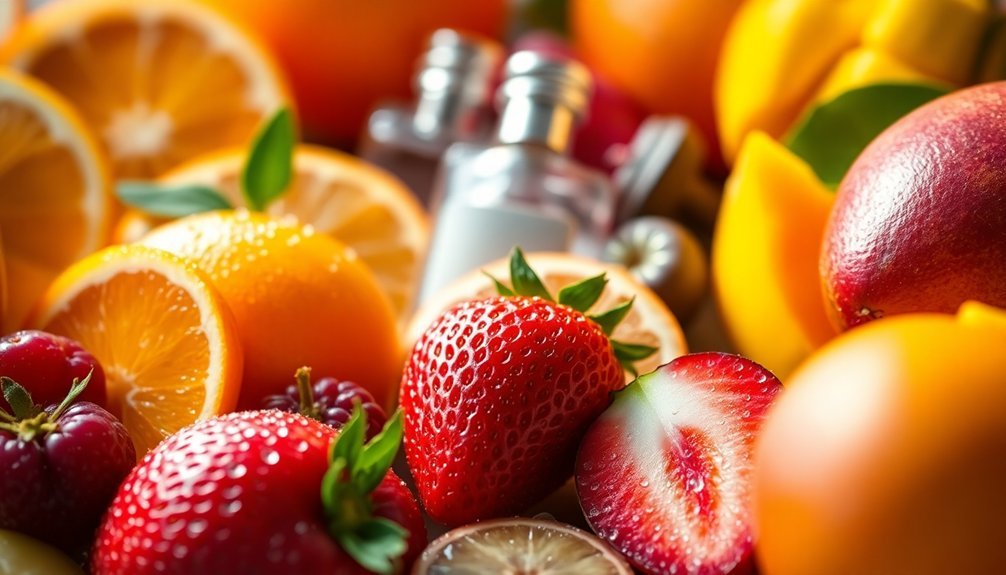
When exploring the world of perfumery, you'll discover that fruit notes fall into distinct categories that help perfumers create balanced and enthralling fragrances.
You'll find red fruits like strawberries and cherries adding sweet, vibrant touches, while yellow fruits such as pineapple and lemon contribute zesty, bright elements to your scent.
If you're seeking freshness, watery fruits like watermelon and melon can provide that aquatic burst. Since natural fruit essences are limited, perfumers rely on synthetic raw materials to achieve authentic fruit notes.
For an adventurous twist, exotic fruits like mango and passionfruit offer unique, tropical dimensions.
Don't forget stone fruits – peach and apricot notes can bring a soft, velvety quality to your fragrance.
Understanding these categories will help you identify the fruit notes that resonate with your personal style and guide you in selecting your perfect signature scent.
Selecting Complementary Base Notes for Fruit Accords
To create a lasting fruit-based perfume, you'll find that woody base notes like cedarwood and sandalwood provide essential anchoring qualities that prevent fruit accords from becoming too fleeting.
Tinctures and hydrosols can enhance fruit fragrances with natural complexity, adding unique depth to the composition. Rich resins such as frankincense and copal contribute depth and complexity while stabilizing the overall composition.
Oriental elements, including vanilla and musk, enhance the fragrance's longevity while adding an alluring warmth that transforms simple fruit notes into sophisticated perfumes.
Woods Anchor Fruit Notes
The art of pairing woody base notes with fruit accords creates depth and longevity in signature perfumes. You'll find cedarwood and vetiver excel at anchoring bright citrus notes, while sandalwood adds warmth to sweet, tropical fruits. For a rich, aromatic foundation, patchouli pairs beautifully with berries and gourmand accents. Oriental blends combine these wood and fruit pairings with exotic spices for an even more complex fragrance profile.
| Wood Type | Best Fruit Pairings |
|---|---|
| Cedarwood | Citrus, Stone Fruits |
| Vetiver | Citrus, Fresh Fruits |
| Sandalwood | Tropical, Stone Fruits |
| Patchouli | Berries, Dark Fruits |
| Guaiac Wood | Berries, Sweet Fruits |
To layer your signature scent effectively, consider adding small amounts of woods in the top notes for immediate depth. In the heart notes, blend woods with florals to create complexity, letting them fully develop in the base for a lasting impression.
Rich Resins Add Depth
Rich resinous base notes transform simple fruit accords into sophisticated, multi-dimensional fragrances.
You'll find that resins like frankincense, myrrh, and Peru balsam add warmth, depth, and complexity to your perfume while acting as natural fixatives to extend its longevity.
Try pairing frankincense with citrus for a crisp yet complex blend, or combine myrrh with stone fruits like peach to create a cozy sweetness.
For tropical fruit accords, pine and fir absolutes add remarkable body, while cistus works beautifully with green apple or pear notes.
The smoky, earthy undertones of these resins will balance your fruit notes' sweetness perfectly.
You'll notice how these rich base notes help create an expansive sillage that evolves beautifully over time, making your signature scent more luxurious and memorable.
Oriental Notes Enhance Longevity
When crafting your signature perfume, oriental base notes offer remarkable staying power while complementing fruit accords beautifully.
You'll find that oriental fragrances feature concentrated oils and complex compositions that naturally extend wear time on your skin.
- Choose rich base notes like vanilla, amber, or musk to create a lasting foundation that supports your fruity top notes.
- Apply your perfume to moisturized skin at pulse points for maximum longevity.
- Layer complementary scented body products to build depth and extend wear time.
- Consider adding woody notes like sandalwood or patchouli to anchor your fruit accords.
Make the most of oriental perfume traditions by incorporating these long-lasting ingredients into your signature scent.
The combination of fruit notes with oriental bases creates a unique, enduring fragrance that stays with you throughout the day.
Mastering Top Note Combinations With Fresh Fruits
Fresh fruit combinations in top notes create the essential first impression of your signature perfume, setting the stage for the entire fragrance experience.
You'll want to focus on highly volatile fruits that make an immediate impact in the first 5-15 minutes of wear. Start by selecting citrus elements like bergamot, lemon, or orange for brightness, then layer in complementary fruits such as peach, lychee, or raspberry for depth.
You can blend these fruits in specific ratios (like 3:2:1) to achieve perfect balance. For summer scents, stick with lighter citrus combinations, while richer fruits work better in cooler seasons.
Don't forget to test your blend on your skin, as chemistry affects how the fruits interact. Anchor your fruity top notes with woody or musky base notes to guarantee your signature scent lasts longer.
Balancing Sweet and Tart Fruit Notes
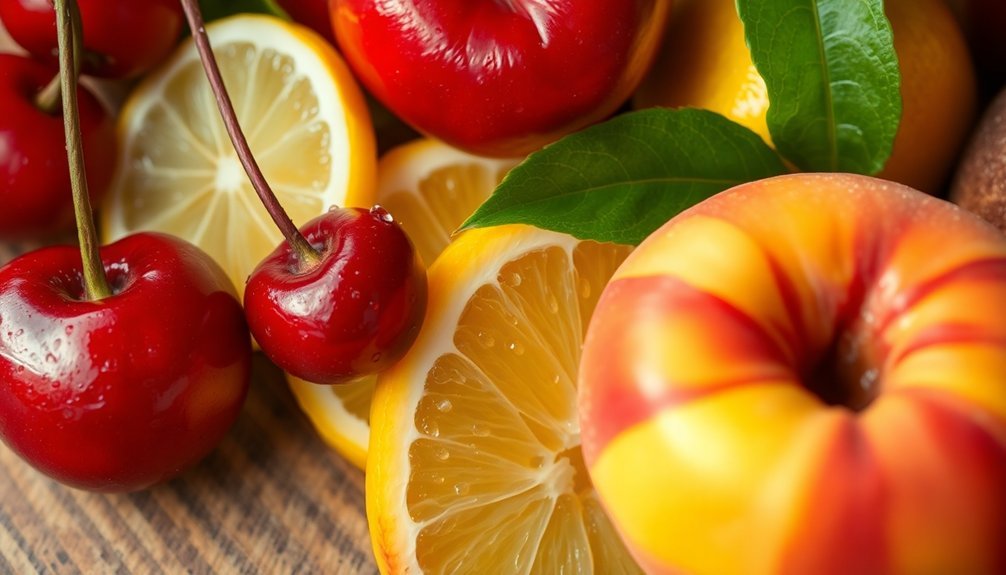
Beyond selecting individual fruit notes, mastering the interplay between sweet and tart elements will elevate your signature scent to new heights.
You'll find that balancing these contrasting aspects creates depth and sophistication in your fragrance.
Key combinations that work exceptionally well include:
- Mirabelle with vanilla and caramel for an indulgent yet balanced gourmand
- Red fruits with chocolate to create a juicy contrast against rich bases
- Tart fruits with floral accords to achieve a fresh, romantic blend
- Fruit notes with citrus to amplify brightness and energy
When crafting your signature scent, remember that sweet fruits can temper heavy base notes, while tart fruits add vibrancy to lighter compositions.
This balance is essential in creating a well-rounded fragrance that's both sophisticated and wearable.
Creating Depth With Dried Fruit Elements
Although fresh fruits bring vibrancy to perfumes, dried fruit elements add a sophisticated layer of complexity that can transform your signature scent. You'll find that prunes and dates work exceptionally well in oriental and gourmand compositions, while dried figs offer an intriguing blend of green and milky facets.
| Dried Fruit | Best Paired With | Effect |
|---|---|---|
| Prunes | Vanilla | Rich depth |
| Figs | Woods | Earthy complexity |
| Apricots | Osmanthus | Floral sweetness |
To create authentic dried fruit accords in your perfume, you'll need to combine natural raw materials with synthetic molecules, as extracting oils directly from dried fruits is challenging. Consider using specialized bases like Prunol De Lair for apricot notes, or enhance your composition by adding complementary spices like cinnamon or cardamom for warmth and dimension.
Techniques for Layering Multiple Fruit Notes

When layering multiple fruit notes, you'll need to contemplate both compatibility and application technique to create a harmonious signature scent. Start by selecting fruits from the same scent family or closely related families using the fragrance wheel as your guide. Apply heavier fragrances first on freshly showered skin, then layer lighter scents on top.
For successful fruit note layering, follow these key practices:
- Combine berry notes with lighter fruits like white peaches for a fresh summer blend.
- Use vanilla or musk as anchoring notes to add depth to your fruit combinations.
- Balance strong fruit notes with softer, powdery elements.
- Allow scents to settle on your skin before making adjustments.
Don't be afraid to experiment with opposing fruit notes, like sweet and tart combinations, to develop your unique signature fragrance.
Remember to start light and build intensity gradually.
Essential Tools and Materials for Fruit-Based Perfumes
Creating your own fruit-based perfume requires a well-stocked collection of both natural and synthetic materials.
You'll need essential citrus oils like lemon, orange, and grapefruit for bright top notes, while synthetic molecules like Aldehyde C14 and C18 are vital for creating realistic peach and coconut accords.
For red fruit notes, you'll want to work with Raspberry Ketone, while Benzyl Acetate helps achieve tropical fruit facets.
Don't forget Melonal for fresh melon notes. Natural extracts from fruits like mango and pineapple can add exotic sweetness, though they're often expensive.
To enhance your fruit notes, consider adding complementary materials like spices (cardamom, coriander), florals (jasmine, ylang ylang), or woods and musks for depth and longevity in your final composition.
Preserving Fruit Notes' Longevity in Your Blend
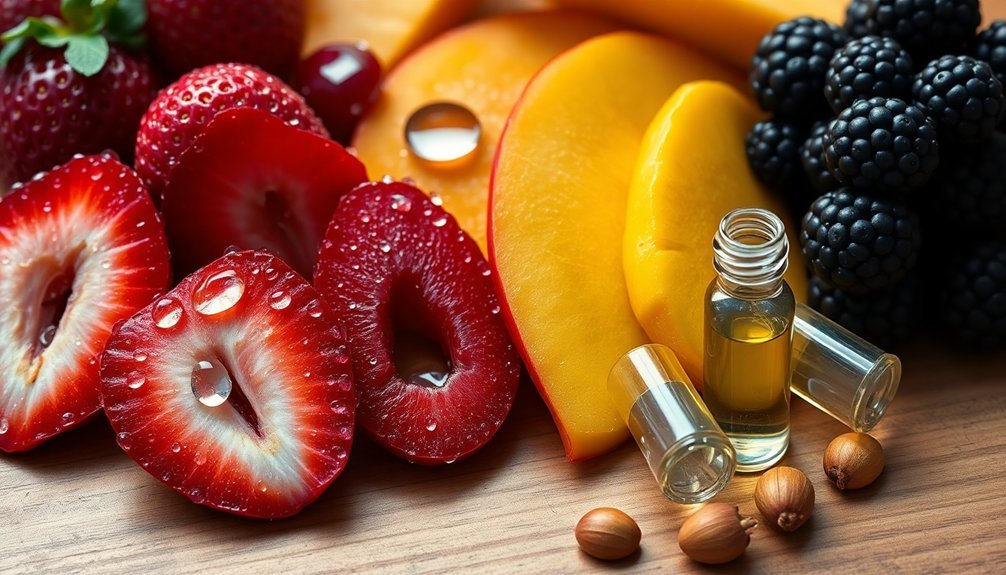
To make your fruit notes last longer in your signature perfume, you'll need to anchor them with substantial base notes.
You can achieve this by layering woody elements like sandalwood or cedar with your chosen fruit accords.
These deeper notes work as a foundation that holds the fruity components in place, preventing them from evaporating too quickly and extending the overall longevity of your blend.
Base Notes Anchor Fruits
The delicate nature of fruit notes in perfumery requires a strong foundation to maintain their vibrancy throughout wear. Base notes, with their large, heavy molecules, act as anchors that prevent your fruity scents from disappearing too quickly.
When you're crafting your signature scent, incorporate these powerful base notes to enhance your fruit notes' longevity:
- Sandalwood and vanilla provide a rich foundation while slowing the evaporation of volatile fruit molecules
- Amber adds depth and complexity to your blend while extending its staying power
- Natural fixatives tether your fragrance to your skin, helping fruit notes linger longer
- Cholesterol-like compounds in base notes work to balance the overall formula and protect its quality
Consider these anchoring elements essential building blocks for a well-rounded, long-lasting fruity perfume that'll stay true throughout the day.
Layer With Woody Notes
Beyond selecting the right base notes, mastering the art of layering with woody notes can greatly boost your fruity perfume's staying power.
Start by applying rich woods like cedarwood, sandalwood, or Oud Alif to create a solid foundation for your fragrance.
Let the woody base settle for about an hour before adding your chosen fruit notes.
You'll want to apply these lighter scents strategically to your pulse points – wrists, neck, and behind your ears.
Don't overdo the fruit elements; a moderate application will complement rather than compete with your woody base.
For maximum longevity, prep your skin with unscented moisturizer before applying any fragrances.
You can also extend the scent's life by using matching scented body products and applying small amounts to your clothing fibers.
Season-Specific Fruit Note Combinations
Creating signature perfumes that resonate with each season requires thoughtful combinations of fruit notes that capture distinct seasonal characteristics.
You'll discover unique pairings for each time of year that enhance your fragrance's seasonal appeal.
- Spring calls for light floral-fruity blends featuring jasmine with apple or black currant, plus zesty citrus combinations that awaken the senses.
- Summer embraces invigorating citrus-mint pairings and tropical fruits like watermelon and passion fruit, creating cool and playful scents.
- Fall demands warm combinations of plum or fig with spicy notes, while amber and woody bases add rich autumnal depth.
- Winter thrives on deep woody notes paired with pomegranate or lychee, plus oriental spices that create luxurious cold-weather fragrances.
Mix and layer these seasonal fruit notes to craft your perfect signature scent that evolves throughout the year.
Troubleshooting Common Fruit Note Issues
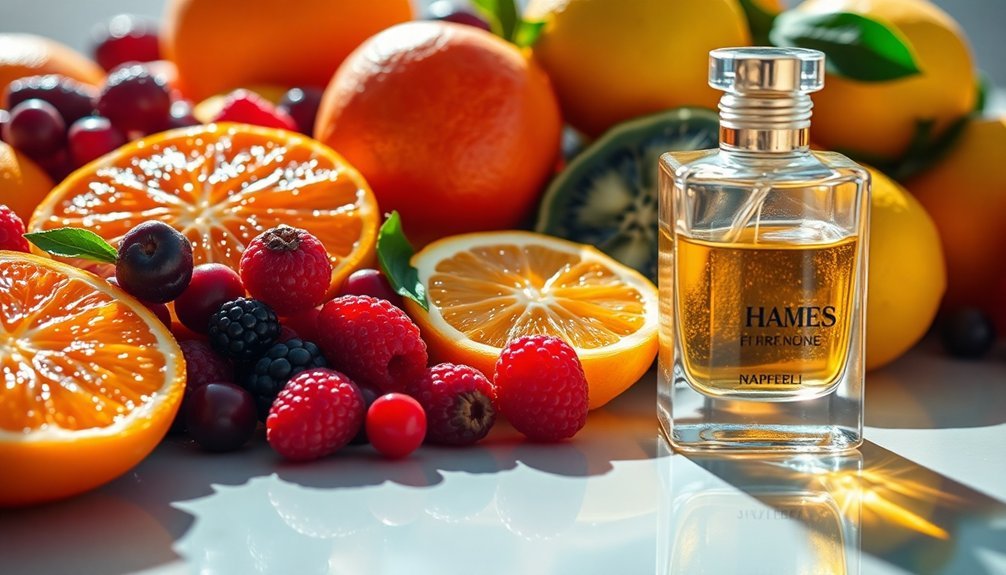
While working with fruit notes in perfumery presents unique challenges, understanding common issues and their solutions will help you create more balanced, authentic fragrances.
If you're experiencing synthetic harshness, try diluting potent molecules like Melonal and strong lactones. When natural fruit extracts fade too quickly, incorporate synthetic molecules like Aldehyde C14 or C18 to enhance longevity.
To prevent your fruity notes from overwhelming the composition, balance them with complementary fragrance families. You'll find that woody notes create sophistication, while florals add depth.
If you're struggling to capture authentic fruit scents, consider blending multiple ingredients rather than relying on a single component. Remember to test different concentrations carefully, as even small adjustments can greatly impact the final fragrance's balance and stability.
Frequently Asked Questions
Can Certain Fruit Notes Trigger Allergic Reactions When Used in Perfumes?
Yes, you'll need to be cautious with fruit notes like citral and limonene in perfumes, as they're common allergens. They can trigger skin reactions, especially if you're among the 1-3% with fragrance sensitivities.
How Do Environmental Factors Affect the Way Fruit Notes Develop?
Your fruit notes will develop differently based on humidity, altitude, temperature, and pollution. High humidity amplifies them, altitude makes them fade faster, temperature changes affect potency, and pollution can dull their scent.
Are Lab-Created Fruit Notes More Sustainable Than Natural Fruit Extracts?
Yes, you'll find lab-created fruit notes are generally more sustainable. They're consistently available, reduce pressure on natural resources, and don't rely on seasonal harvesting. Plus, they require less water and land to produce.
Which Fruit Notes Are Traditionally Considered More Masculine Versus Feminine?
You'll find citrus and crisp fruits like bergamot, grapefruit, and apple in masculine scents, while feminine fragrances typically feature sweet berries, tropical fruits, and stone fruits like peaches and plums.
Do Fruit Notes Interact Differently With Different Skin Chemistry Types?
Yes, your skin chemistry greatly affects how fruit notes perform. If you've got oily skin, they'll last longer and project better, while dry skin makes them fade faster. Moisturized skin helps balance their presentation.
In Summary
Creating your own fruit-based perfume isn't just about mixing scents – it's about crafting a personal aromatic story. You'll know you've succeeded when your blend captures both the vibrancy of fresh fruits and the complexity of complementary notes. Don't be afraid to experiment with different combinations and trust your nose. With practice and patience, you'll develop signature scents that perfectly express your fragrant vision.

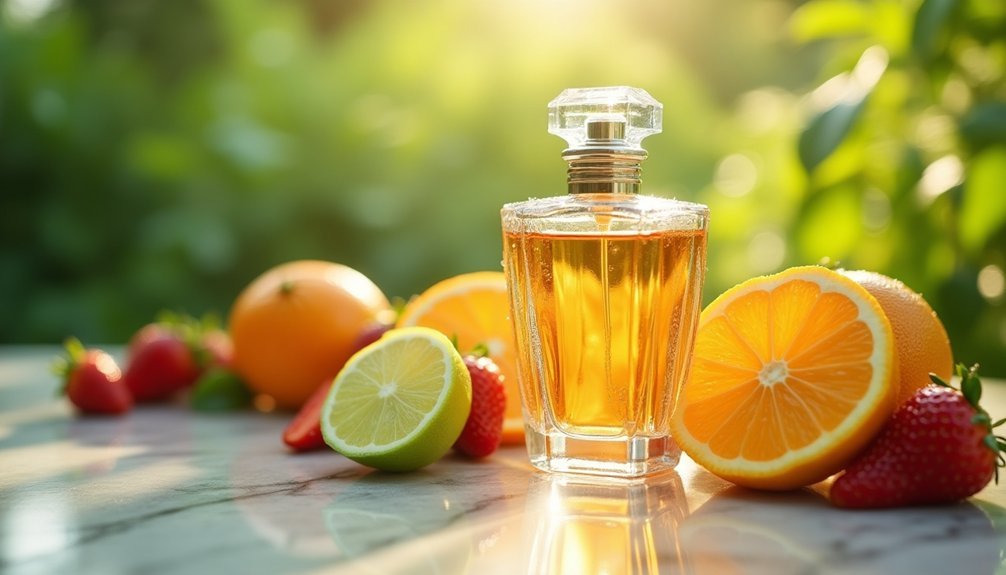



Leave a Reply